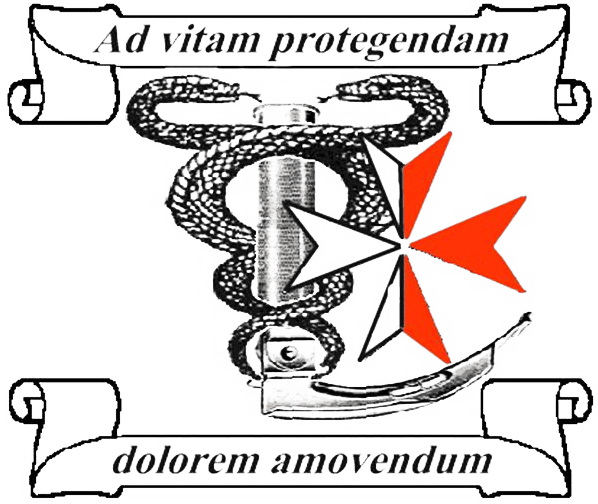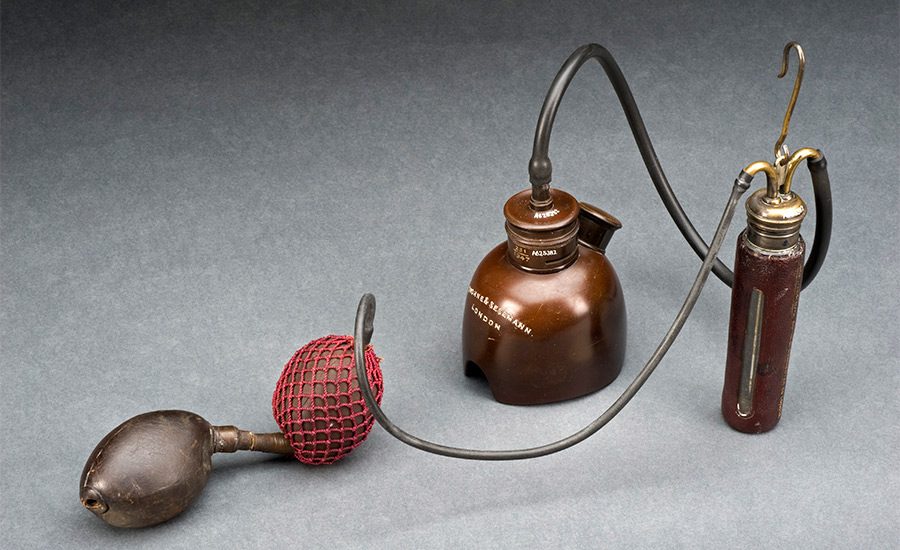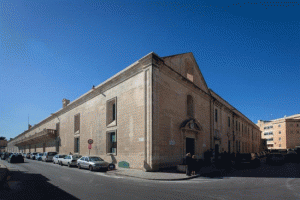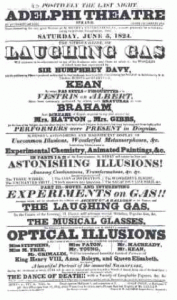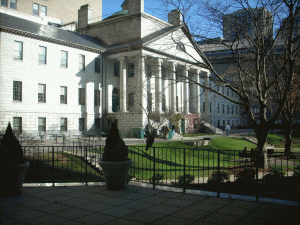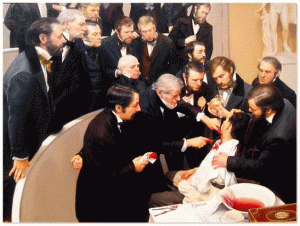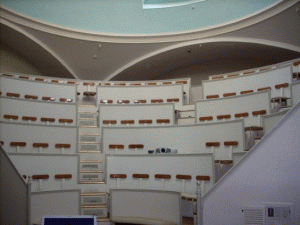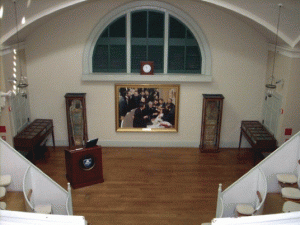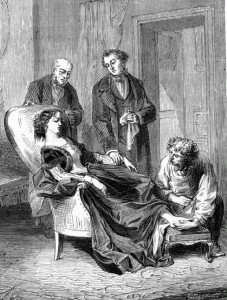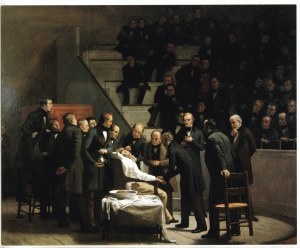Acknowledgement
To Dr David Spiteri, consultant in anaesthesia and intensive care, whose insight into the first drafts of this article proved invaluable for its fruitful completion.
Introduction
The quest to abolish pain of surgery proved beyond reach for centuries.1 Surgery sorely tested the patients’ endurance, the hospital assistants brute strength to hold them down and, above all, the surgeon’s dexterity and speed. The faster the surgeon, the better. Mikiel’Ang Grima, resident surgeon at the Sacra Infermeria in Valletta from 1763 to 1797, was renown for carrying out some major operations in under three minutes.2 Anaesthesia then developed through the coincidental and disparate efforts of contentious pioneers who often became victims of their own discoveries.
The hospital of the Order of St John, the Sacra Infermeria, now the Mediterranean Conference Centre, in Valletta. During its zenith in the late seventeenth century, the hospital boasted single beds and silver cutlery sets for each patient.3
“This pure air may become a fashionable article in luxury”
The classical Greek theory, formulated by Empedocles and supported by Aristotle, that matter is composed of the four elements water, earth, fire and air, survived well into the eighteenth century. Furthermore, in 1667 Georg Stahl and Johann Becher conjectured that combustible bodies contain “phlogiston”, a fire-like element that is released during burning. It was then thanks to Stephen Hales, a physiologist and clergyman in Teddington near London, that experimentation with “airs” began. It was he who in the first half of the eighteenth century set up the apparatus to carry out experiments with different materials and gases.4, 5
Joseph Priestley, another clergyman and chemist from Leeds, used Hales devices to isolate and test a number of gases in common usage today. His seminal work “Experiments and Observations on Different Kinds of Airs”, a series of articles published between 1774 and 1786, described “dephlogisticated air” (he thought this gas absorbed phlogiston, so it must contain less of it to start off with), “nitrous air”, and “dephlogisticated nitrous air”, among many other chemicals. Priestley observed that dephlogisticated air supported combustion five to six times better than common air and thought breathing “this pure air may become a fashionable article in luxury”. In addition, he astutely observed that dephlogisticated nitrous air rendered mice “less lively”.5, 6
The French nobleman Antoine-Laurent Lavoisier, Priestley’s contemporary, realized that combustion involved combining with a gas, rather than the release of something else, and proceeded to fiercely discredit the phlogiston theory. He also renamed dephlogisticated air to “oxygen”. Soon after “nitrous air” and “dephlogisticated nitrous air” were identified as nitric oxide and nitrous oxide respectively.5, 7
“A new era of tooth-pulling!”
The understanding that air was composed of several gases led to attempts of treating lung diseases, particularly tuberculosis, by inhaling these newly-discovered substances. In 1798, Thomas Beddoes, a Shropshire physician educated in Edinburgh, set up the Pneumatic Institute in Bristol for this purpose.5
A 21-year-old surgery apprentice from Cornwall, Humphry Davy, was chosen as laboratory investigator at the Pneumatic Institute. He proceeded to experiment with nitrous oxide, mostly on himself, and in 1800 he published his findings in “Researches, chemical and philosophical, chiefly concerning nitrous oxide, or dephlogisticated nitrous air, and its respiration”. Davy had inhaled nitrous oxide for “a headache after indigestion” and during a bad bout of gingivitis, and he did actually comment that “nitrous oxide in its extensive operation appears capable of destroying pain; it may probably be used with advantage during surgical operations”. Unfortunately, this was ignored. What people enthusiastically picked up on were the descriptions of his state of mind during the experiments.5, 7
“I now had a great disposition to laugh, luminous points seemed frequently to pass before my eyes, hearing far certainly more acute and I felt a pleasant lightness and power of exertion in my muscle. […] By degrees as the pleasurable sensations increased, I lost all connection with external things; trains of vivid visible images rapidly passed through my mind and were connected with words in such manner as to produce perception perfectly novel. I existed in a world of newly connected and newly modified ideas.”5
That is how nitrous oxide got its moniker “laughing gas”. It became wildly popular in parties as a recreational drug and among entertainers in travelling circuses who administered it to volunteers from the audience. It was almost half a century later in the United States that the medical uses of nitrous oxide were investigated again.5, 7
Playbill of a show at the Adelphi Theatre in London in 1824, which included a “laughing gas” demonstration. The original is now held at the Victoria and Albert Museum, London.7
Horace Wells, an eminent dentist from Hartford in Vermont, the US, attended one of these shows, promoted as “a grand exhibition of the effects produced by inhaling nitrous oxide!” and held by Gardner Colton, a medical school drop-out who must have dabbled with nitrous oxide earlier on. During the demonstration Wells noticed that people who inhaled the gas and then injured themselves did not show any signs of pain. He was instantly struck with the idea of extracting teeth under the influence of nitrous oxide. Wells discussed this possibility with his associate John Riggs, and invited Colton to his clinic the following day, December 11, 1844, so that Wells could have a molar removed. Colton administered the gas and Riggs did the extraction. Wells did not wince. Riggs wrote that when he came round from the nitrous oxide “he swung his hands and claimed ‘a new era of tooth-pulling!'”8
Wells successfully administered nitrous oxide on his dental patients and a few months later he travelled to Boston. William Morton, a former dentist and partner of Wells who at the time was studying medicine at Harvard, introduced him to some members of Boston’s thriving medical community and helped him organize the nitrous oxide demonstration. The exact date and location of this are now debated, but it is thought Wells administered the gas to a medical student and extracted a tooth on January 20, 1845. The student cried out in pain and the experiment was deemed a miserable failure.8-10
“Gentlemen, this is no humbug!”
Diethyl ether was first compounded in the Middle Ages first in Persia by Jabir ibn Hayyam and later in Catalonia by Raymond Lully. Its sleep-inducing effect had been observed and recorded by several distinguished scientists throughout the years, including Boyle, Newton and Faraday.11 By the eighteenth century it was wildly popular both as a recreational drug among academics and university students (vapour-fuelled parties were in fact known as “ether frolics”) and as an elixir that could be prescribed for anything ranging from rheumatism to epilepsy and flatulence.10, 12 Although no-one thought of using it to alleviate pain during surgery, it was physicians and dentists who had survived “ether frolics” in their student days who thought of using ether as a surgical anaesthetic.10
The first recorded case was of William Clarke, a medical student, who administered ether during a tooth extraction in January 1842. But it was neither reported nor repeated.8 Then Crawford Williamson Long, a rural physician working in Jefferson, Georgia, used ether to remove a neck cyst in March of the same year. Long realized the implications of this, and continued to use ether in his surgical practice. He only reported his findings in 1849.10, 11
William Morton, the dentist turned medical student, was a member of the audience at Well’s botched demonstration and he too was interested in the development of surgical anaesthesia. He sought the advice of the polymath Professor Charles Jackson, who suggested ether. Jackson was already familiar with ether and had been demonstrating it to his students for some time. Morton was determined to avoid Well’s humiliation and experimented with ether on animals, his assistants and then himself and he also carried out a series of pain-free tooth extractions by using this chemical. Morton then staged a public demonstration at the surgical amphitheatre at the Massachusetts General Hospital on October 16, 1846. He administered ether to Gilbert Abbott and senior surgeon John Collins Warren removed a jaw tumour in a ten-minute procedure. Abbott slept peacefully throughout and when the operation was over, Warren turned to the audience and claimed, “Gentlemen, this is no humbug!”10, 11
The Bulfinch Building at the Massachusetts General Hospital where William Morton used ether as a surgical anaesthetic for the first time on October 16, 1846.
Morton wanted to patent ether and make money out of it. He had included aromatic oils and opium with the ether in order to add colour to the agent and conceal its pungent smell and he refused to reveal what he actually had administered Abbott, calling the mixture “Letheon” instead. However, the hospital did not allow Morton to use mixture unless he declared its true contents. The age of painless surgery had truly begun.10, 11, 13
“Ether Day, 1846” by Warren Prosperi. The Massachusetts General Hospital commissioned this painting to commomerate in 2000 and it was unveiled a year later. Twenty doctors took part in a re-enactment of the event to help in its completion.14
The news of “etherisation” of patients undergoing surgery travelled fast. Jacob Bigelow, a visiting physician at the Massachusetts General Hospital, wrote to his friend Francis Boott, an American doctor living in London, and informed him of Morton’s demonstration.15 Boott discussed the news with his neighbour, the dentist James Robinson, and Robert Liston, a surgeon at the University College Hospital of London. On December 19, 1846, Robinson extracted a patient’s diseased molar under the effect of ether at his home, with the American in attendance.16 Also, two days later Liston administered ether to Fredrick Churchill, a butler, before a leg amputation. The People’s Journal reported this story and triumphantly declared, “We have conquered pain!”17
The surgical amphitheatre at the Bulfinch Building today, now known as the Ether Dome. Prosperi’s painting of that fateful day is hanging at its epicentre.
It is interesting to note that the first successful anaesthetic in Malta, then a British crown colony, was administered in less than three months after the initial demonstrations in London. During January of 1847, Thomas Spencer Wells, a Royal Navy surgeon, started experimenting with ether anaesthesia at the Bighi Naval Hospital using a locally-assembled device. This malfunctioned and diluted the ether with air, and the first ever attempt, a hand amputation, was far from satisfactory. Spencer Wells sent for a Hooper inhaler from England and on March 6, 1847 he provided ether for an operation involving two “large and deep incisions”. Ten days later he proceeded to demonstrate ether to members of the Societa’ Medica d’Incorragiamento, the local medical association of the time. A manual detailing the set up and use of the Hooper inhaler was also published later on in 1847.18, 19
The Naval Hospital at Bighi, now the seat of the Malta Council for Science and Technology, where anaesthesia was administered in Malta for the first time. Note that the tower-like structure on the right is an elevator used to lift injured servicemen from the vessels directly to the hospital.
“The effect was soothing, quieting and delightful beyond measure”
The search for other volatile anaesthetics went on unabated. Chloroform was synthesized in the early 1830s by different people working independently in Germany, France and the United States but it was Robert Glover, a Newcastle physician who had studied in Edinburgh, who first investigated its effect on animals and reported its ability to render them unconscious. However, it seems he did not think of chloroform as a surgical anaesthetic.10, 11, 20
Enter James Simpson, an obstetrician practicing in Edinburgh who, dissatisfied with the pungent and slow-acting ether, sought to use another gas for pain-relief during maternal delivery. David Waldie, a pharmacist who later on gave up medicines and turned to chemical manufacturing instead, suggested chloroform. Simpson first self-experimented with the gas and then had it tested after a dinner party at his home on November 4, 1847. All guests immediately fell asleep. Excited with his success, Simpson reported his findings in The Lancet within a fortnight and started using it on his patients.10, 21
The introduction of chloroform anaesthesia suffered a setback with the tragic death of Hannah Greener, a 15-year-old girl who had was given chloroform for the removal of an in-growing right hallux toe nail on January 28, 1848. The local doctors who did the procedure reported that Greener was dead in less than two minutes and all attempts to resuscitate her proved futile. Sir John Fife, a respected Newcastle surgeon, and Robert Glover carried out the autopsy and concluded the girl died from “lung congestion” caused by inhalation of chloroform. The doctors in question, Meggison and Lloyd, were exonerated.22, 23
An etching depicting Hannah Greener’s death as part of an article published in France in 1868 entitled, “Les merveilles de la science Etherisation” (“The marvels of the science of etherisation”).24
James Simpson and John Snow, a popular London practitioner, repudiated Fife’s and Glover’s conclusion. Simpson argued that the doctors’ attempts at reviving the girl, which involved forcing cold water down her mouth, were to blame for her demise as this would have blocked her airway and asphyxiated her. Snow, on the other hand, criticized the way chloroform was administered, that is, by soaking a handkerchief in chloroform and asking the patient to breathe through it, and which resulted in an overdose. The cause of Greener’s death, the first recorded death due to anaesthesia, was studied for some time. It was later discovered that light chloroform anaesthesia irritates the myocardium and renders it prone to arrhythmias when exposed to adrenaline at the same time. Greener had indeed moved when the doctor did the incision and it was then suggested that she was in fact under-dosed with chloroform and the adrenaline surge resulting from the painful stimulus caused a fatal arrythmia.22, 23
John Snow may very well be considered as the world’s first anaesthetist. He was born in York to a labourer and was apprenticed to a surgeon in Newcastle at the age of 14. He then studied medicine in London and was a highly esteemed practitioner. After the introduction of ether anaesthesia to the United Kingdom in 1846 he worked hard to put this new technique on a sound scientific footing. He developed an inhaler that delivered ether in a controlled fashion and insisted on continuously monitoring the patient during anaesthesia. He also realized the importance of administering anaesthesia that prevents movement to surgical stimuli, apart from causing unconsciousness and reducing pain. Snow’s services were much in demand among London surgeons who insisted on having their patients anaesthesized.11, 23, 25
It was on April 3, 1853 that Snow was summoned to Buckingham Palace for an interview with Prince Albert, consort to Queen Victoria. The Queen was to deliver her eighth baby soon and, against the advice of the royal physicians, the Prince insisted on alleviating her pain during childbirth.8 Victoria went into labour four days later and Snow administered chloroform by pouring small drops of it on a folded handkerchief put over the Queen’s face during the contractions. Charles Locock, one of the royal physicians, thought chloroform was prolonging labour but when Prince Leopold was born, the Queen “appeared very cheerful and well”.26
Queen Victoria was indeed very happy with the result and in fact she wrote in her journal, “Dr Snow gave that blessed chloroform and the effect was soothing, quieting and delightful beyond measure” and requested Snow’s attendance for the birth of her ninth (and final) child, Princess Beatrice, on April 14, 1853.10, 11
The first recoded anaesthetic death in Malta occurred two years later and was reported in the press on April 20, 1855. A 35-year-old healthy man was administered chloroform in a house in Senglea for a toe amputation. The patient suddenly exhibited “a trembling pulse, blood ceased to flow and he expired without a groan”. Following this, the authorities ordered that there should be two doctors present during surgery: one to operate and the other to administer the anaesthetic. Sometime later, a second recommendation was issued, requesting the presence of yet another medical practitioner to monitor the patient’s pulse and colour. In 1911, hospitals in Malta reverted to using ether.18
“The gas war”
The introduction of anaesthesia stirred up a great deal of controversy. On one hand its proponents were unwavering in defending its use to alleviate pain during surgery to improve surgical practice and considered it as a moral obligation to reduce suffering. On the other, many respected medical authorities deemed ether and chloroform as poisons and would not administer them to their patients, especially since the number of chloroform-related deaths was on the rise. Moreover, religious zealots considered pain-relief, especially obstetric analgesia and anaesthesia, as running contrary to God’s will: “Unto the woman He said, ‘I will greatly multiply thy sorrow and thy conception in sorrow thou shalt bring forth children'” (Genesis 3:16). Others declared chloroform anaesthesia as a “decoy from Satan” and there were reports that babies delivered under its influence were refused baptism. The city of Zurich banned the use of anaesthetics completely.10
Simpson retorted by quoting the Bible too: “And the Lord God caused a deep sleep to fall upon Adam, and he slept: and He took one of his ribs, and closed up the flesh instead thereof” (Genesis 2:21). The idea that God himself practised anaesthesia helped sooth people’s fears. More importantly, when John Snow administered chloroform to Queen Victoria for her last two deliveries, she inadvertently gave anaesthesia a royal seal of approval. This helped popularize anaesthesia among the upper and middle classes and, since the British reigning monarch has the dual role of head of the Church of England, it settled this religious dispute in the United Kingdom.10, 11, 23
The Lancet had scathingly attacked the use of chloroform on the Queen in May 1853, even questioning the veracity of the report, but this was borne more out of the antipathy between Snow and Thomas Wakley, the journal’s founding editor and a member of parliament, than out of concern about the safety of chloroform.27, 28 Snow and Wakley had sparred on several issues for a long time, a rivalry which only intensified in 1855 after Snow pinpointed the source of the 1854 cholera epidemic in Soho to a single contaminated public water-pump. He then denied in front of parliamentary committee that fumes from tanneries were the source of cholera. Wakley had been lobbying hard in favour of this theory to have these factories regulated or shut down.28, 29
The Broad Street Memorial Pump on Lexington Street in London, commemorating John Snow’s work on the source of cholera in the 1854 Soho outbreak. The London Board of Health quickly dismantled the offending water-pump but its officials stuck to the “miasma theory” of disease transmission. The importance of Snow’s contribution is highlighted further when considering that Louis Pasteur only began experimenting on germ theory in 1860 and Robert Koch identified Vibrio cholerae in 1883 in India. As late as 1885, health authorities across Europe, but especially in Britain, rejected Pasteur’s and Koch’s work not to have a negative impact on the lucarative maritine traffic through the Suez Canal, which was opened in 1869.29, 30
In the end, it was John Snow’s meticulous practice that worked the most to convince both doctors and patients how useful anaesthesia is.23, 25
There was also a great deal of public quarrelling about who discovered anaesthesia first, what Horace Well’s wife Elizabeth called “the gas war”. Wells was side-lined in the United States but his work received recognition in Europe where the Parisian Medical Society declared him as the first to have discovered anaesthetic gases and apply them to surgery.8 William Morton petitioned to the US Congress three times and was even granted an audience with President Francis Pierce to present his case, but the well-connected Charles Jackson had declared him “a forger and a swindler” for first asking him for advice and then taking credit for the result. Morton’s thwarted plan to patent ether and make a fortune out of it was well-known and definitely did not help his cause. It was Jackson who for a while received popular acclaim.31-33 To compound matters Crawford Long published his work on ether in 1849, stating, “I was determined to wait a few months before publishing an account of my discovery to see whether any surgeon would present a claim prior to the time it was used by me.”34
Similarly in the United Kingdom, Robert Glover hotly contested James Simpson’s claim of discovering chloroform anaesthesia, arguing he published the results of his animal experiments earlier and did not recommended it for use in humans because of its alleged damage to the lungs. Simpson apologized to Glover for missing his publication, courteously (or condescendingly) saying that as a clinician he did not read reports on animal studies.21
“The Republic has no need of scientists”
Worryingly, most of these pioneers in anaesthesia met early and tragic ends to their lives. In the height of the French Revolution Antoine-Laurent Lavoisier was put on trial for being a member of a tax-collecting company and was summarily guillotined in 1794. “The Republic has no need of scientists,” argued the presiding judge.36 Joseph Priestley fled to the United States for supporting the Revolution and died in Pennsylvania at the ripe old age of 71 years.6 Humphry Davy may not have become addicted to nitrous oxide but he did write, “A desire to breathe the gas is always awakened in me by the sight of a person breathing, or even by that of an air bag or an air holder.”5 He was knighted in 1812, made a baron in 1818 and served as president of the Royal Society from 1820 to 1827.37
Horace Wells’ failed nitrous oxide demonstration disturbed him deeply, so much so he gave up his dental practice and only continued to administer nitrous oxide anaesthesia for other dentists and local surgeons in Hartford. He travelled to France in late 1846 to lecture about his work in anaesthesia but returned to the United States and moved to New York City by 1848. Around this time, he started experimenting with chloroform and became addicted to it. It was under its influence that he attacked two women, whom he thought as prostitutes, by throwing a vial of sulphuric acid at them. He committed suicide while under arrest by inhaling chloroform and then slashing open one of his femoral arteries. He was dead at 33 years.8
Morton went on to administer anaesthesia to injured soldiers in the American Civil War but his protracted litigation with Jackson left him impoverished. He died at 48 years of “brain congestion” (probably a stroke) while on his way to New York to contest a recently published article crediting Jackson with the discovery of ether anaesthesia.31, 32 In 1873 Jackson was admitted to a mental asylum where he died seven years later.27 Long died in 1878 while administering ether to a woman in labour.34
In the middle of Crimean War, Robert Glover joined the military corps as a “civil surgeon” and left for Scutari, Crimea, in 1855. He returned to the United Kingdom a year later, heavily addicted to opium and chloroform. He died in 1859, aged 43, when he swallowed almost 150 millilitres of chloroform while Frederick Gant, his friend and former colleague in Crimea, was visiting him.20
John Snow died at 45 years from a stroke.23 Thomas Wakley remained unforgiving even in Snow’s death, writing an obituary so short (37 words in total) that it could be considered offensive. It took The Lancet 155 years to rectify its founding editor’s grudge and publish an obituary befitting such a monumental figure in both anaesthesia and epidemiology.38 On the other hand, James Simpson was knighted in 1866 for services to medicine and when he died four years later at 58 he was given a farewell fit for a king: thousands of people lined the streets of Edinburgh during his funeral.39, 40
Monument to Sir James Simpson built in 1877 and located at the West Princess Street Gardens in Edinburgh.
Conclusion
It may be simplistic of us to only commemorate October 16, the day of Morton’s ether demonstration, as the “World Anaesthesia Day”. The beginnings of anaesthesia are mired in controversy and confusion, and remain the subject of intense research even nowadays. Moreover, the many dramatis personae, with their feuds and addictions, turn the story to a veritable tragic comedy. It is to these people, however, that we owe anaesthesia as we know it, that singular branch of science that revolutionized the way we practice medicine and surgery today.
Robert Hinckley’s famous “The First Operation with Ether”. Hinckley started working on it only 27 years after Morton’s demonstration, in 1882, and finished it in 1894. It has been reproduced and distributed hundreds of times.13
References
Chidiac EJ, Kaddoum RN, Fuleihan SF. Mandragora: anaesthetic of the ancients. Anesthesia & Analgesia. 2012; 115(6): 1437 – 1441.
Savona Ventura C, Buttigieg GG. Michel’Angiolo Grima. The man and his times (1729 – 1798). Association of Surgeons of Malta, 2008.
Vella AP. Storja ta’ Malta Vol II. Malta: Klabb Kotba Maltin; 1979. 322 p.
Guerlac H. Hales, Stephen [Online]. Available at: http://www.encyclopedia.com/science/encyclopedias-almanacs-transcripts-and-maps/stephen-hales. Accessed on October 1, 2016.
Smith WDA. A history of nitrous oxide and oxygen anaesthesia part I: Joseph Priestley to Humphrey Davy. Brit J Anaesth. 1965; 37: 790 – 798.
Encylopedia Brittanica. Joseph Priestley – English clergyman and scientist [Online]. Available at: https://www.britannica.com/biography/Joseph-Priestley. Accessed on September 11, 2016.
Smith WDA. A history of nitrous oxide and oxygen anaesthesia part II: Davy’s researches in relation to inhalation anaesthesia. Brit J Anaesth. 1965; 37: 871 – 882.
Jacobsohn PH. Horace Wells: discoverer of anaesthesia. Anesth Prog. 1995; 42: 73 – 75.
Haridas RP. Horace Well’s demonstration of nitrous oxide in Boston. Anaesthesiology. 2013; 119(5): 1014 – 1022.
BLTC Research. Utopian surgery: Early arguments against anaesthesia in surgery, dentistry and childbirth [Online]. Available at: http://www.general-anaesthesia.com. Accessed: September 10, 2016.
Whalen FX, Bacon DR, Smith HM. Inhaled anaesthetics: an historical overview. Best Practice & Research Clinical Anaesthesiology. 2005; 19(3): 323 – 330.
BLTC Research. An account of the extraordinary medicinal fluid called aether [Online]. Available at: http://www.general-anaesthesia.com/misc/ether-turner.html. Accessed on September 10, 2016.
Lloyd P. Robert C. Hinckley and the recreation of “The First Operation Under Ether”. N Engl J Med. 1994; 331: 281.
Vose ML. The Prosperi Studio – About Us [Online]. Available at: http://www.prosperistudio.com/about-us/. Accessed on October 2, 2016.
Ellis RH. The introduction of ether anaesthesia to Great Britain. Anaesthesia. 1976; 31: 766 – 777.
Ellis RH. James Robinson – England’s true pioneer of anaesthesia. Proceedings from the Third International Symposium on the History of Anaesthesia. March 1992: 153 – 64.
BLTC Research. Robert Liston (1794 – 1847) [Online]. Available at: http://www.general-anaesthesia.com/people/robert-liston.html. Accessed on: September 10, 2016.
Azzopardi N. The history of the development of general anaesthesia in Malta. Malta Medical Journal. 2009; 21(3): 42 – 48.
Savona-Ventura C. the naval career of Sir Thomas Spencer Wells in the Mediterranean: 1842 – 1853. Malta Medical Journal. 1998; 10(2): 41 – 46.
Defalque RJ, Wright AJ. The short, tragic life of Robert M. Glover. Anesthesia. 2004; 54: 394 – 400.
Defalque RJ, Wright AJ. The discovery of chloroform: Has David Waldie’s role been exaggerated? Anaesthesiology. 2011; 114: 1001 – 1005.
Pears B. The short, sad life and tragic death of Hannah Greener [Online]. Available at: http://www.bpears.org.uk/Misc/Short_Sad_Life.pdf. Accessed on: September 10, 2016.
Ramsay MAE. John Snow, MD: anaesthetist to the Queen of England and pioneer epidemiologist. Proc (Bayl Univ Med Cent). 2006; 19: 24 – 28.
Club de l’histoire de l’anesthésie et de la réanimation. Premier déces au chloroform: Hannah Greener [Online]. Available at: http://char-fr.net/SITE/Premier-deces-au-chloroforme.html. Accessed: October 8, 2016.
Caton D. John Snow’s practice of obstetric anaesthesia. Anaesthesiology. 2000; 92: 247 – 252.
UCLA Fielding School of Public Health. Birth of Prince Leopold [Online]. Available at: http://www.ph.ucla.edu/epi/snow/leopold.html. Accessed on: September 10, 26.
UCLA Fielding School of Public Health. Critical reaction of The Lancet [Online]. Available at: http://www.ph.ucla.edu/epi/snow/lancet1853reaction.html. Accessed on: September 10, 2016.
Froggatt P. John Snow, Thomas Wakley and The Lancet. Anaesthesia. 2002; 57: 667 – 675.
Paneth N. Assessing the contributions of John Snow to epidemiology. Epidemiology. 2004; 15(5); 514 – 516.
Auyang SY. Reality and politics in the war on infectious diseases [Oonline]. Available at: http://www.creatingtechnology.org/biomed/germs.htm. Accessed on: October 1, 2016.
BLTC Research. William Morton (1819 – 1868) [Online]. Available at: http://www.general-anaesthesia.com/people/william-morton.html. Accessed: September 10, 2016.
Encyclopedia Brittanica. William Thomas Green Morton – American surgeon [Online]. Available at: https://www.britannica.com/biography/William-Thomas-Green-Morton. Accessed September 11, 2016.
BLTC Research. Professor Charles Jackson (1805 – 1880) [Online]. Available at: http://www.general-anaesthesia.com/people/charles-jackson.html. Accessed September 12, 2016.
Crawford Williamson Long (1815 – 1878) [Online]. Available at: http://www.general-anaesthesia.com/images/crawford-long.html. Accessed: September 10, 2016.
Encyclopedia Brittanica. Charles Thomas Jackson – American physician and geologist [Online]. Available at: https://www.britannica.com/biography/Charles-Thomas-Jackson. Accessed September 11, 2016.
The Robinson Library. Antoine-Laurent Lavoisier – the first to describe oxygen and the developer of chemical nomenclature [Online]. Available at: http://robinsonlibrary.com/science/chemistry/biography/lavoisier.htm. Accessed on: Septemebr 10, 2016.
Sir Humphry Davy (1778 – 1829) [Online]. Available at: http://www.bbc.co.uk/history/historic_figures/davy_humphrey.shtml. Accessed on September 10, 2016.
Hempel S. John Snow – Obituary. The Lancet. 2013; 381: 1269 – 1270.
BLTC Research. Professor James Young Simpson (1811 – 1870) [Online]. Available at: http://www.general-anaesthesia.com/people/james-simpson.html. Accessed: September 10, 2016.
Gazetteer for Scotland. Sir James Young Simpson (1811 – 1870) [Online]. Available at: http://www.scottish-places.info/people/famousfirst60.html. Accessed on September 11, 2016.

